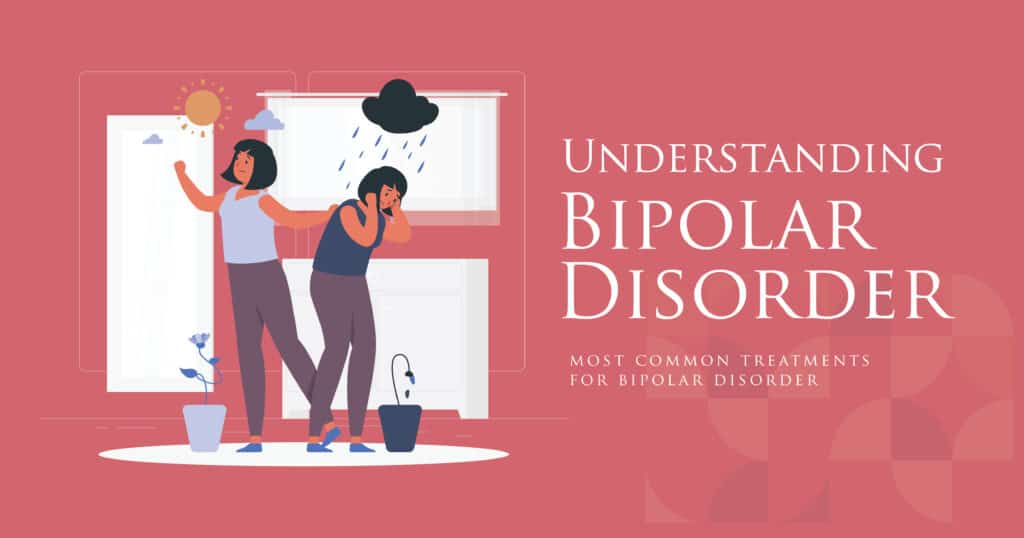Imagine feeling on top of the world one moment, only to crash into a deep, dark pit the next. That’s a glimpse into the life of someone with bipolar disorder, a lifelong illness. This mental health condition isn’t just about mood swings; it’s about navigating extreme highs and lows that can disrupt daily life. In this article, we’ll explore “Understanding Bipolar Disorder | most common treatments for bipolar disorder,” delving into what it is, its symptoms, causes, and the best treatments available. Whether you’re seeking information for yourself or a loved one, let’s take this journey together toward better understanding and management.
What is Bipolar Disorder?
Bipolar disorder, also known as manic depression, is a psychological mental illness characterized by significant mood swings. These swings include emotional highs (episodes of mania or hypomania) and lows (severe depression). It’s a lifelong condition that requires continuous management, as the brain structure and chemistry of individuals with bipolar disorder may contribute to these extreme shifts in mood.
San Jose Mental Health
Types of Bipolar Disorder
There are various types of bipolar disorder, each with unique characteristics:
- Bipolar I Disorder: Characterized by severe episodes of mania lasting at least seven days or requiring immediate hospital care. Depressive episodes also typically occur, lasting at least two weeks.
- Bipolar II Disorder: This involves patterns of hypomanic symptoms and episodes of depression, but without the full-blown manic episodes seen in Bipolar I.
- Cyclothymic Disorder: This is a milder form of bipolar disorder, involving periods of hypomanic and depressive symptoms that last at least two years.
San Jose Mental Health
Manic or Hypomanic Episode Symptoms
- Elevated Mood: Feeling excessively happy or euphoric.
- Increased Energy: High energy levels or activity, feeling unusually energized.
- Irritability: Exhibiting an irritable mood that may seem out of character.
- Lack of Sleep: A lack of sleep without feeling tired, as little as just a few hours of rest.
- Inflated Self-esteem: Inflated self-esteem or a sense of special abilities or special powers during a manic phase.
- Impulsive Behavior: Engaging in Impulsive behavior, such as reckless driving or spending excessive amounts of money.
Depressive Episode Symptoms
- Persistent Sadness: A depressed mood where the individual feels sad or hopeless nearly every day.
- Fatigue and Loss of Energy: Loss of energy and persistent tiredness, even with adequate rest.
- Appetite Changes: Excessive appetite or a lack of appetite for food, leading to noticeable weight changes.
- Suicidal Ideation: Thoughts of death or suicidal ideation, especially during severe depression.
Understanding Bipolar Disorder | Most Common Treatments for Bipolar Disorder
Managing bipolar disorder effectively usually involves a combination of treatments. Here are some of the most common approaches:
Medications
Medications are often the first line of treatment for bipolar disorder. They help stabilize mood and manage symptoms:
- Mood Stabilizers: Medications like Lithium are known for their effectiveness in treating both manic symptoms and depressive episodes. These are considered proper treatment to manage mood symptoms.
- Antipsychotic Medications: Drugs like olanzapine and risperidone help manage psychotic symptoms that may appear during severe mania or depression.
- Antidepressant Medication: These are used to treat major depression but are often prescribed with mood stabilizers to prevent triggering a manic episode.
- Anticonvulsants: Medications like valproate are also used as effective treatment for stabilizing mood.
Psychotherapy
Psychotherapy plays an integral role in treatment. It helps individuals understand their disorder, cope with mood swings, and improve their overall quality of life:
- Cognitive-Behavioral Therapy (CBT): This helps people change negative thought patterns that lead to episodes of mania or depression.
- Family-Focused Therapy: This involves the entire family in the therapeutic process, improving communication and support at home, especially when episodes of depression or mania occur.
- Social Rhythm Therapy: Designed to help regulate daily functioning and daily habits like sleep and activity patterns.
Lifestyle Changes
In addition to medical treatments, adopting healthy habits and lifestyle changes can make a big difference in managing bipolar disorder:
- Regular Exercise: Helps regulate activity levels and contributes to mental well-being.
- Healthy Diet: Maintaining a balanced diet can have positive effects on both mood and overall brain function.
- Sleep Hygiene: Ensuring healthy sleep habits is crucial in preventing episodes of hypomania or depression.
San Jose Mental Health
FAQs
What triggers bipolar episodes?
Common triggers include stress, sleep disturbances, substance abuse, and significant life changes. Environmental factors like stress or lack of sleep can precipitate a mood episode. Managing these triggers is key to long-term stability.
Can bipolar disorder be cured?
Bipolar disorder is a chronic mental illness without a cure. However, it can be effectively managed through lifelong treatment, including medications, therapy, and Complementary health approaches like magnetic stimulation or Light Therapyis.
Is medication necessary for treating bipolar disorder?
Yes, medications are often necessary for the effective treatment plan of bipolar disease, but they should be combined with therapy and lifestyle adjustments for the best results. A healthcare professional can provide the correct bipolar disorder diagnosis and create a personalized treatment plan.
Conclusion
Understanding bipolar disorder and its treatments is essential for managing this complex condition. With the right combination of ongoing treatment involving medication, therapy, and lifestyle changes, individuals with bipolar disorder can lead fulfilling lives. If you or a loved one is experiencing bipolar disorder symptoms, don’t hesitate to seek professional help. A care team can provide the support needed to navigate the challenges of this lifelong commitment.








